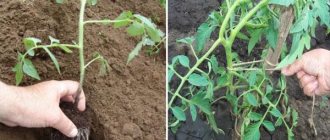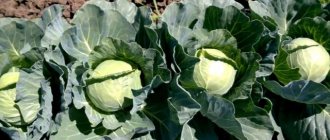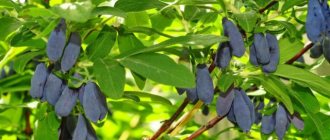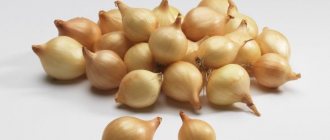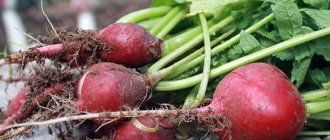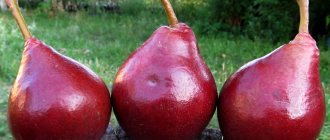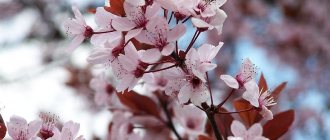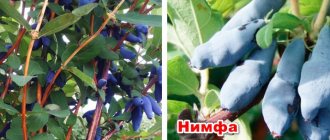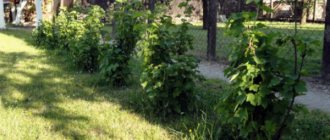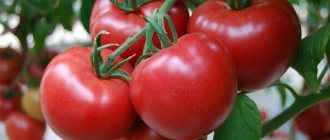History of selection
The varieties of Vladimir Nikolaevich Dederko have long established themselves as the most persistent and productive: Pudovik, Babushkin Secret, Spetsnaz - they will satisfy the requirements of the most sophisticated gourmet and will not present any difficulties when growing both in beds and in a greenhouse. One of these specimens that has earned respect and people’s love is the Honey Saved tomato. It was bred under the leadership of our contemporary, Novosibirsk breeder V.N. Dederko co-authored with other researchers.
This variety was first discussed in 2004; Honey Spas was officially registered in the State Register of Varietal Achievements of the Russian Federation in 2006. Currently, these tomatoes are presented in the assortment of Novosibirsk agro.
Honey Spas has been known for more than 15 years; over these years it has become clear that this variety is the leader in taste and yield among orange-yellow tomatoes.
Tomatoes are intended for growing in greenhouses, but in the southern regions they can also be effectively planted in open ground. According to the type of ripening, they are represented by a mid-season crop. The growing season varies from 90 to 105 days.
Attention! The plant is thermophilic, therefore it is grown in open ground exclusively in the southern regions of the country, and in the central regions greenhouses are used.
In the northern regions of the Russian Federation, exclusively heated greenhouses are used.
Description of the tomato Honey Spas
The variety appeared as a result of the successful work of Novosibirsk breeders. In 2006, an entry was made into the State Register about a new variety of tomatoes, Honey Spas, which was approved for cultivation in greenhouses and open ground in various climatic regions.
The description of Honey Spas tomatoes states that the variety is indeterminate (growth is not limited), mid-season: from planting seeds to harvesting - 3.5-4 months.
- The bush is tall. The plant reaches 1.6 m in unprotected soil and 2-2.5 m in a greenhouse.
- The stems are loose and flexible. To prevent them from breaking, mandatory pinching (removal of shoots) and garter are required.
- Dark green foliage densely covers the stems of the bush. The leaves are small, with serrated edges.
- The root system of the Honey Spas tomato variety is strong and well developed. The main rhizome sits deep in the ground, medium-sized roots are located close to the soil surface.
According to gardeners, the description and photo of the Honey Spas tomato variety on the seed package in most cases corresponds to what grew in the beds.
Features of the variety
The plant is classified as a salad tomato. The tall giant reaches 110–160 cm when grown outdoors, but can reach a height of over 2 m in a covered greenhouse. Large green leaves grow densely on the stems. Flowering is moderate. The cultivar belongs to the group of mid-ripening varieties; the first fruits of the ground Honey Spas in Central Russia ripen in the second ten days of July, in more northern regions - 2 weeks later. With greenhouse forcing, you can enjoy the first tomatoes, similar in color to tangerines, at the beginning of July; with early planting - at the end of June.
A characteristic feature of Honey Spas tomatoes is their indeterminate nature. Bushes are not limited in growth. Thus, growing this type of tomato is more labor-intensive: you will have to attach not only the central stem to the trellis, but also numerous side shoots. Considering the large-fruited nature of the cultivar, fruit clusters are often tied up in this case, and Honey Spas can produce from two to five full-sized tomatoes in one cluster.
The bushes of this tomato must definitely be tied to a reliable support and regularly pruned
The yield of the cultivar when grown in open ground ranges from 4 to 5.6 kg/m2, while heavy tomatoes can grow both on the first shoots closer to the soil surface and at the very top. Some fans of large-fruited tomatoes claim that with regular feeding, the variety’s yield can exceed 20 kg/m2, but such points are best verified experimentally.
In greenhouses, gardeners achieve the maximum output of Honey Spas - from 12 to 17 kg per square meter
The most comfortable conditions for the effective fruiting of a tall cultivar can be created in a greenhouse: here a mid-season variety bears fruit until frost, the sweetness is not lost, the taste and aroma of the pulp remain at their best.
Tomatoes are sometimes picked before they are fully ripe, because even slightly unripe and not yet filled with juice, the fruits of this tomato have a pleasant aroma and taste.
Even the slightly unripe fruits of Honey Spas have a pleasant taste
The variety is perfect for barrel fermentation, marinating in large containers, it is also indispensable in fresh summer salads, and will exquisitely highlight the taste of pizza and quick snacks. Adjika is prepared from the pulp of Honey Spas tomatoes; pieces of tomatoes are added to vegetable stew and preserved in a spicy marinade for the winter. A good result can be obtained by distilling the harvest into juice.
Description of the tomato variety Honey Spas from the State Register
The bush is indeterminate, that is, tall, and does not grow. The ripening period is mid-season. Tomatoes are round, and unripe ones have dark green shoulders. Fruit weight – 160-218 g.
Ripe tomatoes of Honey Spas are orange in color. Their taste is rated “excellent”. The yield is 5.6 kg per square meter, in the greenhouse it is almost three times higher - 15 kg from the same area.
Let's take a look at the information from the bag: per 1 sq. m. It is recommended to plant 3 plants. It turns out that from a bush you can get a maximum of 5 kg, a minimum of 1.9 kg.
The variety is resistant to heat, tomatoes can easily be transported from the dacha to home. They retain commercial quality for a long time.
Description of the Honey Spas variety from a bag of “Siberian Garden”
The shape of the fruit is kidney-shaped. In the State Register - round.
Fruit weight – up to 600 g.
Color – honey yellow.
The taste is very pleasant, sweet, without acid.
Ripening period is average.
Bush height – 120-160 cm.
Productivity – 4-5 kg per bush. This almost coincides with the maximum indicator from the State Register.
Growing rules
In the central and northern regions of Russia, tomatoes of any variety are planted as seedlings. In the south of the country, tomatoes are planted by seeds in the soil.
Planting seedlings
Seeds begin to be sown in late February - early March. You can buy ready-made soil for planting at a specialty store or prepare it yourself.
Subsequence:
- The soil and containers for sowing seeds are disinfected. The soil is heated or watered with hot water (at least 95 degrees) with the addition of potassium permanganate.
- The seeds are soaked in a pale pink solution of potassium permanganate, then rinsed and dried.
- Take a pot or any container and bury 2-3 seeds into the soil (no more than 1.5 cm). Cover with film and place in a warm, well-lit place.
- When the first sprout appears (in a week), the film is removed and the pot is placed in a cooler place.
As the Honey Spas tomato seedlings grow, it will become clear which of them is the strongest. Those that are weaker should be removed. If you plant the seeds in a common container, picking cannot be avoided.
Caring for seedlings involves watering. It is necessary to water without allowing the soil to dry out. It is not recommended to heavily moisten the soil, as the seedling will rot. Feeding with an infusion of wood ash will not hurt - it is used to water the sprouts at the root.
Tomato transplant
Young seedlings are transferred to open ground or a greenhouse only after the soil has warmed up, when the threat of night frosts has passed and the temperature does not drop below 15-16 degrees.
Before planting seedlings, it is necessary to properly prepare the soil:
- Organic matter (manure, compost or humus) is added.
- Ash or ash solution must be added; it contains many useful substances necessary for the growth of tomatoes.
- After planting, the seedlings are immediately tied to a support.
- New shoots from the sides are removed weekly.
Important! The plant is created with one stem, maximum two.
Subsequent care for tomatoes
In order not to be left without a harvest, you need to care for tomatoes:
- water, loosen, remove weeds;
- apply fertilizing;
- mulch;
- tie up.
Loosening the soil facilitates oxygen access to the root system. Tomatoes are watered infrequently, but a lot. 6-7 liters of water are poured under each bush no more than every 3 days.
As indicated in the description, in reviews, gardeners advise to spray Honey Spas tomatoes with a weak solution of boric acid. Tomatoes “love” this feeding. They also feed with an infusion of cow manure or freshly cut grass (water at the root).
Mulching is an important point in caring for tomatoes. Slightly withered grass or hay is laid out on the soil under and around the plant, creating a cushion up to 10 cm high. It is recommended to mulch at least 3 times per season. Before laying a new layer, it is advisable to sprinkle the previous one with “Shine 2” or spill it with “Baikal” solution. They can be purchased at a specialty store. How to prepare these products for use is indicated on the packaging. The compositions speed up the process of processing mulch, nourish, slow down the growth of weeds, and prevent the soil from drying out.
Characteristics of the tomato variety Honey Spas
Tomatoes are large in size - the weight of one varies from 200 to 600 g.
The shape is heart-shaped, slightly rounded. The skin is smooth and dense, rich bright orange. There are few seeds in tomatoes. The tomatoes taste sweet and sour, juicy.
Honey Spas is a high-yielding tomato. Summer residents harvest about 4-5 kg of tomatoes from one tomato bush. Vegetables ripen gradually throughout the summer, which allows you to enjoy the delicate taste of tomatoes longer.
Productivity and fruiting
The crop is not too picky about growing conditions and care, which is why it bears fruit in open ground or a greenhouse, in drought or cool weather. Reviews of Honey Spas tomatoes confirm that the variety produces generous harvests, especially when grown in a greenhouse. In unprotected soil conditions, the yield is more modest.
Important! To ensure a happy harvest, tomatoes should not be planted more often than two or three plants per square meter.
One flower cluster of tomatoes of the Honey Spas variety contains 4-5 fruits. In order for the tomatoes to grow large, the remaining ovaries are removed, otherwise they will interfere with each other's filling. From one bush in a greenhouse, 6-7 kg of wonderfully fragrant tomatoes are harvested, up to 5 kg in open ground.
In the greenhouse, the fruiting period is longer (until mid-October). In open ground, tomatoes are often harvested green. They pour perfectly when stored at home on a windowsill or in a dark place.
Resistance to diseases and pests
As stated in the description of Honey Spas tomatoes and reviews from gardeners, tomatoes are quite resistant to common diseases:
- late blight;
- apical and gray rot;
- tobacco mosaic.
Diseases are less likely to affect the fruits of Honey Spas than other varieties. The threat to culture is:
- whiteflies;
- slugs;
- aphid;
- Colorado beetle.
Harvest and storage
The Honey Spas tomato is primarily valued for its long fruiting period. The first tomatoes can be harvested already on the 90th day after planting, the last ones before the first frost. At the same time, you can harvest brown tomatoes in the fall, as they can ripen perfectly at home. It is worth noting that even at the full stage of maturity, the fruits retain their taste and commercial qualities for a long time at a temperature of +2–3 degrees.
From all of the above, we can conclude that the Honey Spas variety is a productive and unpretentious crop. By planting several bushes in your garden plot, you will be able to get your fill of tasty and healthy tomatoes all summer and winter. At the same time, the tomato produces good seed material for further propagation.
Advantages and disadvantages
- In addition to those positive qualities that have already been mentioned above, Honey Spas has the following advantages:
- has pronounced dietary properties, thanks to which it can be consumed by people with problems in the gastrointestinal tract and those suffering from allergic reactions when eating red tomatoes;
- fruits can be preserved for several months without losing their valuable qualities;
- produces a lot of tomato juice, which has beneficial qualities and almost no contraindications;
- able to adapt to different climatic conditions;
- is resistant to most diseases and pests that usually affect nightshade crops;
- the fruits have a pleasant taste.
- The disadvantages, among which there are practically no serious ones, most often include:
- unsuitability for preservation of fruits of this variety;
- high demands on soil quality;
- the need for frequent pinching throughout the growing season;
- inability to grow without tying up.
Reviews
It is interesting to read the reviews of those who have already planted this variety. Here are some impressions:
Elena
I’ve been planting these tomatoes in a greenhouse for several years, I really like them, they’re really sweet, really honey-like, juicy! In cross-section they are unusual, reminiscent of an outlandish fruit. The bushes are very tall and require frequent staking. The yield is low, but the taste characteristics cover all the shortcomings!
N. N. Korkin
I would like to plant interesting varieties. Planted "Honey Spas". It’s now fun in the greenhouse - you can immediately see which tomatoes are ripe and which are not. The tomatoes taste good. They say they are not canned. My wife makes wonderful tomato juice from tomatoes - it stores well and tastes good.
Osipenko Alla
Honey saved tomatoes are powerful, strong, when you plant them, tie them up right away. I have 5 bushes in the greenhouse - seven are fed with salads all summer.
Lyudmila, Kharkov
This is my favorite - fruitful, delicious, honey-sweet. I form it into 3 trunks and collect the seeds. It lies well and settles down.
Olga
I liked the taste of the tomatoes, but, unfortunately, my tomatoes became ill with cladosporiasis.
V. N. Troshkin.
The variety is elegant, reliable, and productive. The bush is powerful, the leaves are large, the flesh is dense, honey-like. I recommend.
Alyona
I’ve been planting honeycombs for 3 years now, I really like it, the taste is excellent, the juice is delicious! I collect the seeds myself every year, the seedlings are successful. Productivity increased in the second year of cultivation.
Planting tomatoes Medov saved for seedlings
To get a tasty harvest, pay special attention to preparing the seedlings.
Sowing time
Typically, seeds of this variety are planted to obtain seedlings in early March. However, depending on climatic conditions, this period may shift in one direction or another if you use the rule that 60 days must pass from the moment of sowing the seeds to planting the seedlings in open ground.
Did you know? The presence of serotonin in tomatoes, which is also called the “happiness hormone,” allows them to compete in raising people’s mood even with the recognized authority in this regard - chocolate.
Planting seedlings in a permanent place
This moment is determined by two factors:
- the air and soil in the open air should warm up steadily;
- 60 days must pass from the moment of sowing the seeds.
Typically this time in different regions falls in mid-May to early June. For beds that are being prepared in the fall, elevated places are chosen, protected from the active movement of air masses.
The best predecessors of tomatoes are:
- cucumbers;
- beet;
- carrot;
- cabbage;
- onion;
- legumes.
But it is highly not recommended to plant tomato seedlings on the soil after growing on it:
- eggplant;
- potatoes;
- tobacco;
- pepper
You should also not plant tomatoes after tomatoes until 3 years have passed. Plants must be planted in such a way that per 1 sq. m there were no more than three of them. In this case, the depth of the holes, pre-treated with a weak manganese solution and enriched with two spoons of potassium and phosphorus fertilizers, is determined by the need to deepen the earthen ball with the root system to such an extent that the soil poured on top of it reaches the lower leaves of the seedlings. Tomatoes transplanted to a permanent location require immediate watering with warm water.
Prevention from diseases
According to breeders, this variety is resistant to various diseases, but preventive spraying is recommended.
Some gardeners advise not to use chemicals, but to replace them with cotton pads soaked in iodine, or spray with iodine solution (1 tablespoon per bucket). Also, laundry soap (rub and dissolve in warm water) helps against insects.
Cure for late blight
Caring for Tomatoes Honey Saved
Honey Spas seedlings planted in open ground require subsequent care in the form of:
- glaze;
- feeding;
- stepsoning;
- garters.
Watering
After watering with warm water immediately after transplanting, the seedlings are then watered the next time a week later. It should be taken into account that the Honey Spas variety does not tolerate stagnation of water, so it is necessary to water it, focusing on the degree of drying of the top layer of soil under the bush. In addition, it is highly undesirable to water with cold tap water using a hose. The ideal option for irrigation is rainwater collected in barrels and heated under the sun. It should be poured exclusively under the bush, avoiding water drops getting on the leaves.
Pests and diseases
The tomato variety Honey Spas is quite resistant to diseases. It is little susceptible to late blight, gray rot, tobacco mosaic and other viral and fungal diseases.
However, in a greenhouse or open ground, tomatoes can become infected from representatives of other varieties. To prevent planting, it is recommended to spray with phytosporin or other non-toxic biological preparations.
In the garden, tomatoes are threatened by naked slugs, cutworms, Colorado potato beetles, aphids and whiteflies.
Regular spraying with ammonia diluted in water helps against flying insects and slugs. Watering the soil with a solution of copper sulfate or potassium permanganate will help kill the parasite larvae. A soap solution used to treat the affected plants will help remove aphids.
Honey Spas is a very productive variety. It is enough to plant a few bushes; they will provide all the needs of the gardener. If desired, you can collect seeds for subsequent sowings yourself; they will give better germination in the 2nd or 3rd year.
Photo
For a more thorough study of the Honey Spas variety, you can see the photographs below.
This is a variety for aesthetes who love salads. Sliced yellow tomatoes combined with herbs and red tomatoes are a great addition to the summer table. Plant a couple of Honey Spa bushes in a greenhouse or garden bed and please yourself and your loved ones with sunny tomatoes.
